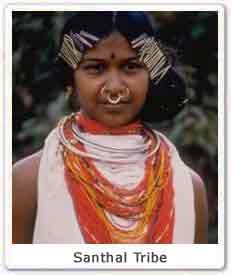Santhals are the third largest tribe in India. They are mostly found in the states of West Bengal, Bihar, Orissa, Jharkhand and Assam.
History of Santhals :
Santhals belong to the Pre Aryan period. They were the great fighters during the British regime in India. They wagged war against the permanent settlement of Lord Cornwallis in 1855. During the late 1850 Santhals hero Sidhu had accumulated around 10 thousand Santhals to run parallel government against the British government. Baba Tilka Majhi was the first Santhal leather who raise weapons against the Britishers in 1789.
 Language
and Identification :
Language
and Identification : Santhals speak Santhali, which belongs to the Austro- Asiatic language family. Santhals have their script called Olchiki, which was developed by Dr Raghunath Murmu in 1925. Accoring to the census their population is around 49,000. They are generally Bilingual. Apart from Santhali they also speak Bengali, Oriya and Hindi. Santhals have long head and flat nose. Their complexion varies from dark brown to black in colour. Santhals usually have curly hair.
Santhal Economic Status :
The livelihood of the Santhals revolve around the forests they live in. They fulfill their basic needs from the trees and plants of the forests. Apart from this they are also engaged in the haunting, fishing and cultivation for their livelihood. Santhals posses the unique skills in making the musical equipments, mats and baskets out of the plants. This talent is safely passed on from one generation to the other.
Culture :
Santhals love dancing. It is in their blood. Dance is the important part of the Santhals fairs and festivals. After the long day hard work, Santhals relax themselves with the light music music and dance. Santhal women dress in the red bordered white sari and dance in the line sequence. Apart from dance Santhals play great music using Tirio (bamboo flute with the seven holes), Dhodro banam (which consists of belly called lac covered with an animal skin on which rests the bridge(sadam, lit, horse), an open chest( korom), a short neck(hotok)and a head( bohok), Phet banam (a fretless stringed instrument with three or four strings), Tumdak, Tamak, Junko and Singa.
Religion :
Santhals have no temples of their own. They even do not worship any idols. Santhals follow the Sarna religion. The God and Goddess of Santhal are Marangburu, Jaheraera, and Manjhi. Santhals pay respect to the ghosts and spirits like Kal Sing, Lakchera, Beudarang etc. They have village priests known as the Naiki and shaman Ujha. Animal sacrifices to the Gods is the common practice common practice among the Santhals to appease the Gods and Goddess.
Festivals :
Santhals mainly celebrate the Karam festival which falls in the month of September and October. They celebrate this festival to plaes the God to increase their wealth and free them from all the enemies. It is the tradition among the Santhals to grow the Karam tree outside their house after the purification process. Other festivals of the Santhal community include Maghe, Baba Bonga, Sahrai, Ero, Asaria and Namah. They also celebrate haunting festival called Disum sendra on the eve of Baishakhi Purnima.






